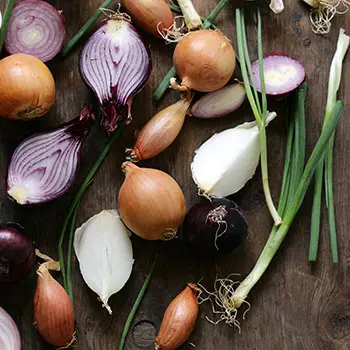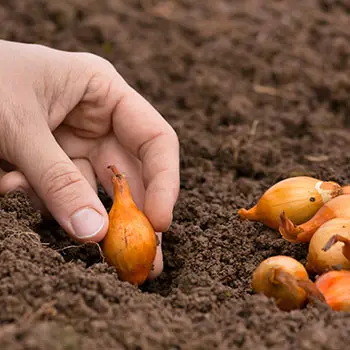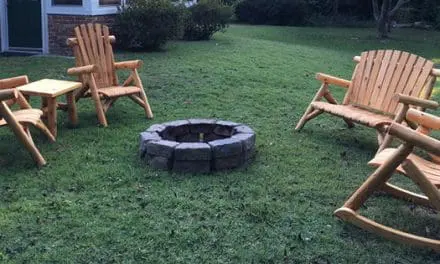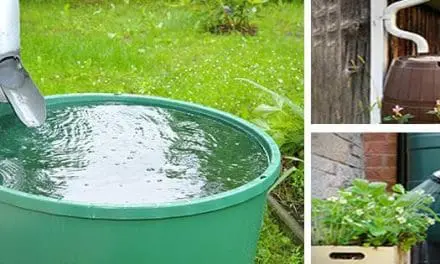Deep dishes, tacos, rice bowls, roasts—no matter what dish you think of, onions will surely be a tasty part of it. But how amazing it would be if those onions came straight from your own garden. How cool is that?
Onions are not only a kitchen staple but also easy to grow, making them perfect for any homesteader. There are also several practical ways to use onions around your homestead.
In this guide, we’ll walk you through the simple steps to plant onions, care for them as they grow, and harvest them at just the right time. So, let’s dig in and get started on this flavorful adventure.
Want to plant and harvest delicious onions right in your backyard or even on your kitchen counter? It’s simple! Just follow these easy steps:
Onion Varieties
When choosing onions for your homestead, think about how each type can serve both in the kitchen and around your property. Here are some options to consider:
- Yellow Onions: Great for cooking, especially when caramelized. They’re also natural disinfectants for minor cuts and packed with antioxidants that support heart health.
- Red Onions: Perfect for fresh dishes like salads and salsas. They have anti-inflammatory properties, and their skins can be used as a natural dye. Red onions may also help balance blood sugar.
- White Onions: With a sharp, intense flavor, they’re great for stir-fries. They can also repel pests in the garden and boost your immune system with vitamin C.
- Green Onions (Scallions): Excellent as garnishes or in salads. Easy to regrow from kitchen scraps, and packed with vitamins for bone and eye health.
- Sweet Onions (Vidalia): Milder in flavor, perfect for sweet dishes. They’re also useful as a chest congestion remedy and last longer when stored properly.
Choose Between Onion Sets and Seeds
Now that you’ve picked out your favorite onion varieties, it’s time to decide how to grow them. You can choose to plant onion sets or seeds. Planting onion sets are a fantastic option if you’re just starting your gardening journey or don’t have much space. They’re easy to grow and require minimal maintenance.
On the other hand, if you have a bit more experience and a larger backyard, consider planting seeds. This option allows you to experiment with a variety of onion types. Plus, it is such a pleasant feeling to watch your harvest flourish from tiny sprouts into full-grown onions.
Select the Right Time to Plant
Onions are hardy plants that can thrive almost any time of year. However, for fresh harvest, consider planting them in early spring. This timing allows you to enjoy a bountiful crop by early summer.
Additionally, before you start planting, take a moment to review your garden zone. You can easily find this information by entering your postal code on an official garden hardiness website. Knowing your zone will help you determine the best planting strategies for your area.
Related: How To Make Your Own Vertical Onion Planter
Prepare the Soil
Choose a sunny spot with well-draining soil, as onions thrive in loose, fertile conditions with a pH level between 6.0 and 7.0. To enhance soil quality, consider mixing organic matter like compost or well-rotted manure with the soil. Additionally, before planting, clear the area of any weeds or debris, and use a garden tiller to loosen the soil, ensuring it is well aerated.
However, using clay pots is an excellent option if you’re considering planting onions indoors or in a smaller space. First, select a pot at least 6 to 12 inches deep and wide enough to accommodate multiple onions comfortably. Moreover, ensure that the container has drainage holes to prevent water accumulation, which can lead to root rot.
Plant the Onions
Once your soil is prepared, it’s time to plant those onions. If you’re using onion sets, simply position them in the soil with the pointed end facing upward. This orientation is crucial for proper growth. Be sure to space them about 4 to 6 inches apart to allow each onion ample room to develop into a healthy bulb.
In contrast, if you’ve chosen to plant seeds, sow them about half an inch deep and cover them lightly with soil. After covering, gently pat the soil down to ensure good contact with the seeds and promote optimal germination.
Water and Care for Your Onions
After planting your onions, keeping the soil consistently moist is important to encourage healthy growth. However, be cautious not to overwater your crops, as excessive moisture can lead to root rot and other issues. A good rule of thumb is to water deeply but infrequently, allowing the top inch of soil to dry out between waterings.
Related: DIY Ingenious Rainwater Harvesting Systems
Harvesting Your Onions
Onions are usually ready when the tops start to fall over and turn yellow about 90 to 100 days after planting. This indicates they’re ready for harvest. When you observe this, gently loosen the soil around the bulbs with a garden fork.
Afterward, pull the onions from the ground and let them cure in a dry, warm location for a few weeks. This curing process is essential, as it helps extend their shelf life and enhances their flavor.
Why Onions?
Onions are one of those crops you’ll definitely want to have on hand. They’re so much more than just a tasty ingredient for cooking. For starters, onions can help keep pests away in your garden. Planting them alongside your veggies can keep things like aphids, mosquitoes, and even rabbits at bay because they don’t like the smell.
But the benefits don’t stop there. Onions are packed with nutrients. Yellow and white onions, for example, are full of antioxidants, which are great for heart health and boosting your immune system. Red onions are a bit milder and have anti-inflammatory properties, making them perfect for regulating blood sugar. Sweet onions, like Vidalia, are great for more than just cooking—they can help with chest congestion when used as a poultice.
Onions are also easy to preserve. You can dehydrate or can them, which makes them a fantastic addition to your emergency food stores. Plus, they store well in a cool, dry place, so you don’t have to worry about them going bad quickly.
And here’s a handy tip: you can regrow green onions (scallions) right from kitchen scraps! Just stick the roots in some water, and you’ve got fresh onions again in no time. So, whether it’s for your garden, health, or food storage, onions are a homesteader’s secret weapon!
What Happens When You Pour Sugar Into An Onion? (Video)
Frugal Lessons From My Grandfather Who Lived Through The Great Depression
















